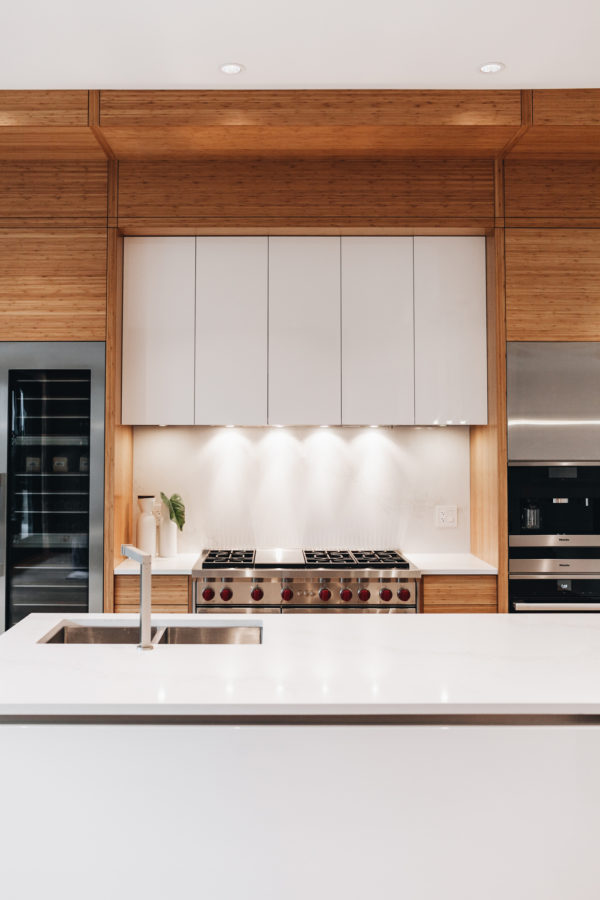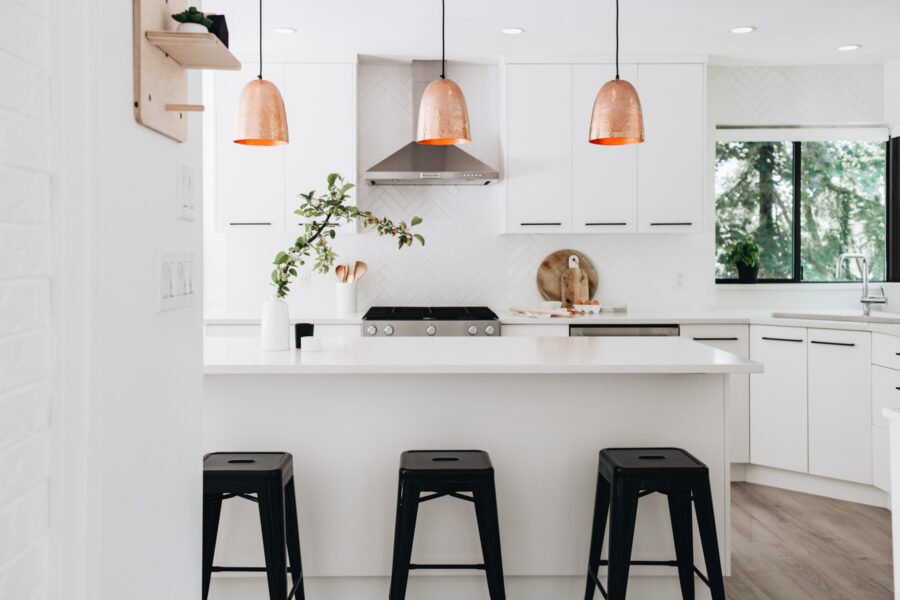
Kitchens are unique spaces that often double as more than just a place to cook and eat. Kitchens are gathering places, meeting spaces, and rooms to enjoy on a personal level during either the day or night. The lighting in the kitchen can shift and tweak the energy of the room based on the time of day, emotion of the situation unfolding in the space, or the activity that requires some light.
Further to providing homeowners with the ability to see what’s in front of them, lighting is also crucial for creating emotion and a particular ambiance. Different lighting may help to create very different energies and emotions, despite the room remaining the same.
This emotional play that lighting is responsible for is an important design attribute that deeply contributes to the character and identity of your new kitchen. In this post, we’ll explain how lighting contributes to a richness in your kitchen that can’t be replicated by any other means.
Planning
With so many options available on the market today, it’s a tough set of decisions to pick out your lighting cues — and pre-planning during a kitchen rebuild or renovation means you’ll be imagining the ambiance you wish to create with lighting that’s not available to be previewed in your specific space. You may find that you adore a specific light fixture, but upon completion of your kitchen it doesn’t throw enough light – or isn’t the colour of light you envisioned. There’s also spacing to consider, sizes of fixtures, and juxtaposing style that can create a sharp and unwanted design contrast in the room.
But have no fear – the power of your decisions is easily upheld by a thoughtful pre-planning stage to consider any and all options.
Some lighting decisions can be left until the room is complete, but others – like under cabinet lighting can be very difficult and time-consuming to install after the building process has been completed. Think ahead and consider creating a mock-up or 3D CAD drawing with your kitchen designer. This floor plan can help you to understand the spaces you have to illuminate, and how best to give each zone its own special lighting design — and there’s the first pro tip: have several sources of lighting so you can customize and adjust the emotion of the room at will.
Layering your lighting scheme allows you to give the cook in the family the ideal light for the food prep space, while the morning island coffee drinker has the perfect lighting to read the paper. Under cabinet lighting helps create a sense of drama in an open concept kitchen showcasing the finishes of the space and helps integrate the kitchen into the overall living room or post-meal conversation area.
Layering Mood
There are four main types of lighting to consider in a layered approach to mood-inspiring kitchen lighting, and each is responsible for creating emotion in different ways:
- General Lighting
- Task Lighting
- Ambient Lighting
- Decorative Lighting
Ambient lighting is all about creating a space that welcomes all who enter. It’s the warm embrace of a good friend, or the proverbial handshake we need to feel like we belong. Ambient lights can include various track lighting used to illuminate special works of art on the walls, or highlight special sections of the kitchen — say the stovetop, or the new under mount sink.
Task lighting are all about specific kitchen-centric jobs like food prep, dish-washing, and use of appliances. They can include strip lighting mounted underneath cabinets, and down ceiling lights mounted in a dry storage pantry, or even pendant lights above the kitchen island.
General lighting is just that, lighting that is needed to generally illuminate the room, and can include standardized ceiling lights in the form of pot lights, and down lights. Decorative lighting is commonly used to draw attention to a special area of the room, or to draw the eye upwards to help elevate the room. Think of decorative lighting in terms of chandeliers, stylish pendant lights, and anything that helps to add some style and a distinct aesthetic to the room. Most importantly, decorative lights can differentiate from other lighting in the house because they’re function is primarily to be noticed.

Layering these components in the kitchen will allow you to create different moods and emotions depending on the unique combinations of lighting you choose to use at one time. For example, having the task lighting over the island on a dimmer switch, and the decorative lighting highlighting a piece of art in the kitchen may create a nice warm space for enjoying a glass of wine after dinner. Alternatively, a busy kitchen during mealtime may choose to utilize only the general lighting and some under cabinet lighting to help shed some light on food prep spaces, helping to boost the energy in the room.
Pendants Lights

Pendants are typically hanging lights that appear over kitchen islands and peninsula work spaces. They are unique and adaptable lighting features in that they provide not only task lighting, and general lighting, but can also be interpreted as decorative lighting as well. Choosing the appropriate pendant lights can be one of the most troublesome — and exciting —
As a general rule, pendants lights should be positioned at an approximate 60-70 cm above the surface of the countertop, but this formality is critically dependent on the physical size of the pendant itself. A larger pendant should be placed higher, and a smaller pendant can be permitted to hang lower.
Pot/Strip Lights
Mounting pot lights or strip light LED’s underneath cupboards is a fantastic way to not only elevate the overall aesthetic of a kitchen, but also adds a task light that helps evenly distribute light on a specialty backsplash and countertop.
Despite being an older kitchen lighting tactic, pot lights are still an effective way to embrace mood and create emotion with lighting because they’re so adaptable and ready to do what they need to do. They can both act as general lighting with a bright white LED bulb, and as ambient lighting when connected to a dimmer and featuring warm yellow light. They can create warmth, and even-lit working spaces – and can very easily accent a fantastic set of pendant lights.
Chandeliers
Not too commonly found in a kitchen, chandeliers are making a name for themselves as innovative and creative alternatives to more classic kitchen/dining room decorative lighting solutions — plus, not all chandeliers have to follow the dated crystal aesthetic from yesteryear, or the rustic antler fixtures that have been the darlings of Pinterest for years.
When sourced well, chandeliers can act as a pendant light, and bring some serious flare to a kitchen space. It’s important to note their epitomized over-the-top style can be distracting and can create some serious contrast in the room – though a tasteful selection can match well with general and task lighting. In open concept spaces that combine eating and kitchen areas, chandeliers can be difficult to match with the rest of the lighting in the room, so following a strict style guide and/or matching materials is a must.
Light Colour
Light color plays as much a role in the energy and emotion of a space as the light fixture it comes from. Typically, bright white LED light is a staple of general lighting used to brighten up the entire space, while warmer LED’s can also be found that help bring a sense of character, warmth, and emotion into a space much like selecting the best colour palette for your life. In modern kitchen designs, reserve the bright whites for task lighting, while using the warmer lights in pendants and other forms of ambient and decorative lighting.

Modern trendy kitchen with light blue faded coral color furniture. 3D rendering.
Natural Light
The psychological benefits of having access to nature, green spaces and natural views is a huge bonus in implementing good design strategies for a modern kitchen. Apart from some stunning natural illumination, the psychological benefits of an increase of natural light include stress reduction, increased innovative thinking, benefits your vision and ability to sleep, and improves your mood overall.
![]()

So while not a lighting design consideration, it’s certainly a profoundly important element of kitchen design that impacts enjoyment of your new space, as well as your metaphysical and psychological enjoyment of not just your kitchen, but life! Increased exposure to natural light can be achieved by knocking down a wall, installing a larger window, or even by painting your kitchen to a brighter colour that helps better reflect light.
No one likes to cook in the dark — or a clinically bright space with little character or warmth.
Creating emotion in your kitchen with light helps increase the value of your renovation or rebuild – light is a critical aspect of boosting your enjoyment of the space, and dramatic ambiance accentuated by light helps elevate the elegance and prestige of the kitchen. Layered lighting design helps give your kitchen multiple personalities that all contribute to unique emotions and settings, but also improves your ability to use and enjoy the kitchen as the functional heart of your home.